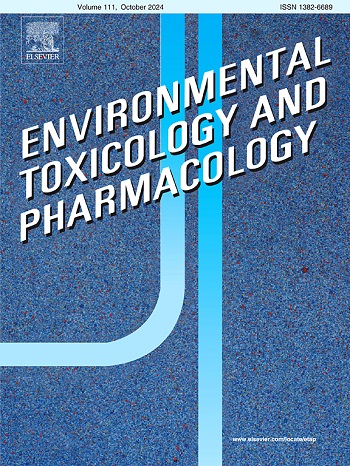Dual environmental stressors: How pH modulates antibiotic toxicity in Danio rerio?
IF 4.2
3区 环境科学与生态学
Q2 ENVIRONMENTAL SCIENCES
引用次数: 0
Abstract
Aquatic ecosystems are increasingly subjected to environmental stressors, including pH fluctuations, and antibiotic contamination, which can disrupt essential biological functions such as metabolism, respiration, and reproduction. The interaction between these stressors presents significant ecological risks, as pH affects the toxicity, pharmacodynamics/kinetics of antibiotics by altering their ionization state and membrane permeability. This study assessed the toxicity of environmentally relevant concentrations of sulfamethoxazole (150 µg SMX/L), trimethoprim (30 µg TRIM/L), and their mixture (MIX: 150 µg SMX/L + 30 µg TRIM/L) under different pH conditions (6.5, 7.5, and 9.0) on Danio rerio juveniles. A multi-biomarker approach was used to assess D. rerio biological health status, including oxidative stress responses, lipid peroxidation, cholinergic neurotransmission, energetic metabolism, and DNA damage. Results revealed that SMX was marginally toxic across all pH scenarios, but caused more severe effects such as oxidative stress, lipid peroxidation, and DNA damage, under acidic pH. In contrast, TRIM toxicity increased at neutral and alkaline pH, causing severe alterations in antioxidant defenses and cellular integrity. The MIX treatment exhibited marginal toxicity at acidic and alkaline pH but was moderately toxic at neutral pH, leading to oxidative stress, lipid peroxidation, and DNA damage. These physiological and metabolic disruptions highlight how antibiotic mixtures, under varying pH conditions, can impair critical biological functions in aquatic organisms. These findings emphasize the urgent need for integrated research addressing multiple environmental stressors, particularly chemical contamination and climate change-driven abiotic factors. Ignoring these threats could lead to irreversible damage to aquatic ecosystems and biodiversity.
双重环境应激源:pH值如何调节达尼奥鱼的抗生素毒性?
水生生态系统越来越多地受到环境压力的影响,包括pH波动和抗生素污染,这可能会破坏基本的生物功能,如代谢、呼吸和繁殖。这些压力源之间的相互作用带来了显著的生态风险,因为pH通过改变抗生素的电离状态和膜通透性来影响抗生素的毒性、药效学/动力学。本研究评估了环境相关浓度的磺胺甲新唑(150 µg SMX/L)、甲氧苄啶(30 µg TRIM/L)及其混合物(MIX: 150 µg SMX/L + 30 µg TRIM/L)在不同pH条件(6.5、7.5和9.0)下对斑马鱼幼鱼的毒性。采用多生物标志物方法评估d.r reio生物健康状况,包括氧化应激反应、脂质过氧化、胆碱能神经传递、能量代谢和DNA损伤。结果显示,SMX在所有pH值下都具有轻微毒性,但在酸性pH值下会引起更严重的氧化应激、脂质过氧化和DNA损伤。相反,TRIM在中性和碱性pH值下毒性增加,导致抗氧化防御和细胞完整性的严重改变。MIX处理在酸性和碱性pH值下表现出边际毒性,但在中性pH值下表现出中度毒性,导致氧化应激、脂质过氧化和DNA损伤。这些生理和代谢破坏突出了抗生素混合物在不同pH条件下如何损害水生生物的关键生物功能。这些发现强调了迫切需要对多种环境压力因素进行综合研究,特别是化学污染和气候变化驱动的非生物因素。忽视这些威胁可能会对水生生态系统和生物多样性造成不可逆转的损害。
本文章由计算机程序翻译,如有差异,请以英文原文为准。
求助全文
约1分钟内获得全文
求助全文
来源期刊
CiteScore
7.00
自引率
4.70%
发文量
185
审稿时长
34 days
期刊介绍:
Environmental Toxicology and Pharmacology publishes the results of studies concerning toxic and pharmacological effects of (human and veterinary) drugs and of environmental contaminants in animals and man.
Areas of special interest are: molecular mechanisms of toxicity, biotransformation and toxicokinetics (including toxicokinetic modelling), molecular, biochemical and physiological mechanisms explaining differences in sensitivity between species and individuals, the characterisation of pathophysiological models and mechanisms involved in the development of effects and the identification of biological markers that can be used to study exposure and effects in man and animals.
In addition to full length papers, short communications, full-length reviews and mini-reviews, Environmental Toxicology and Pharmacology will publish in depth assessments of special problem areas. The latter publications may exceed the length of a full length paper three to fourfold. A basic requirement is that the assessments are made under the auspices of international groups of leading experts in the fields concerned. The information examined may either consist of data that were already published, or of new data that were obtained within the framework of collaborative research programmes. Provision is also made for the acceptance of minireviews on (classes of) compounds, toxicities or mechanisms, debating recent advances in rapidly developing fields that fall within the scope of the journal.

 求助内容:
求助内容: 应助结果提醒方式:
应助结果提醒方式:


